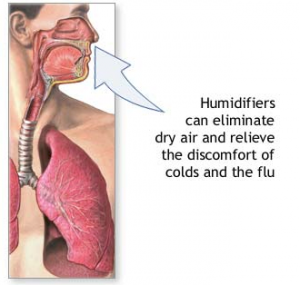Humidity and Humidifiers
Humidifiers Control Humidity:
 The word humidity refers to the amount of water vapor in the air. When it comes to humidity inside, tell-tale signs are dry sinuses, bloody noses, cracked lips itching, sneezing and coughing, and they’re not limited to the summer months. Humidifiers can ease problems caused by dry air, humidifiers can help soothe these familiar problems caused by dry indoor air. Humidifiers can also help ease symptoms of a cold or another respiratory condition. But they need regular maintenance.
The word humidity refers to the amount of water vapor in the air. When it comes to humidity inside, tell-tale signs are dry sinuses, bloody noses, cracked lips itching, sneezing and coughing, and they’re not limited to the summer months. Humidifiers can ease problems caused by dry air, humidifiers can help soothe these familiar problems caused by dry indoor air. Humidifiers can also help ease symptoms of a cold or another respiratory condition. But they need regular maintenance.
But be cautious: Although useful, humidifiers can actually make you sick if they aren’t maintained properly or if humidity levels stay too high. If you use humidifiers, be sure to monitor humidity levels and keep your humidifier clean. Dirty humidifiers can breed mold or bacteria. If you have allergies or asthma, talk to your doctor before using a humidifier.
Indoor Humidity
Indoor symptoms arise when people have allergic reactions to the organisms that thrive in humidity.
Humidity promotes mold growth and dust mite population growth. Both are significant indoor allergens and can set off allergic sensitivity and can trigger rhinitis and asthma, These are things that people can’t see or feel, but they live on countertops, table surfaces, carpet, pillows, mattresses — just about anywhere that people are, and they depend on warm temperatures and high humidity to live and grow.
If the presence of mold or dust mites sends you for a tissue or your doctor’s office, then keeping the humidity inside your home at 50 percent or lower may provide some relief. Lower humidity will result in lower mold and dust mite growth.
Ideal Humidifier Levels
Humidity is the amount of water vapor in the air. The amount of humidity varies depending on the season, weather and where you live. Generally, humidity levels are higher in the summer and lower during winter months. Ideally, humidity in your home should be between 30 and 50 percent. Humidity that’s too low or too high can cause problems.
Too Dry
Low humidity can cause dry skin, irritate your nasal passages and throat, and make your eyes itchy.
Don’t let the air inside your house get too dry. Skin irritation, difficulty breathing and static electricity are among common problems that develop when indoor humidity is too low.
Low indoor humidity is a bigger issue in winter months, when heaters and cooler temperatures combine to lower the moisture levels in the air.
Too Wet
High humidity can make your home feel stuffy and can cause condensation on walls, floors and other surfaces that triggers the growth of harmful bacteria, dust mites and molds. These allergens can cause respiratory problems and trigger allergy and asthma flare-ups.
The airborne water can be detrimental to your home, as well as your health. High humidity in a home can cause rot. And, especially in the South, it draws pests. Bugs are always looking for water. Condensation provides bugs with the water they need to live and multiply. If you don’t build properly, moisture can condense inside walls and cause rot. It’s not obvious on the outside, but it could be rotting on the inside and not seen for years
What Are Humidifiers?
 Humidifiers are devices that emit water vapor or steam to increase moisture levels in the air (humidity). There are several types:
Humidifiers are devices that emit water vapor or steam to increase moisture levels in the air (humidity). There are several types:
- Central humidifiers are built into home heating and air conditioning systems and are designed to humidify the whole house.
- Ultrasonic humidifiers produce a cool mist with ultrasonic vibration.
- Impeller humidifiers produce a cool mist with a rotating disk
- Evaporators use a fan to blow air through a wet wick, filter or belt.
- Steam vaporizers use electricity to create steam that cools before leaving the machine. Avoid this type of humidifier if you have children; hot water inside this type of humidifier may cause burns if spilled.
Humidity Meter
The best way to test humidity levels in your house is with a hygrometer. This device, which looks like a thermometer, measures the amount of moisture in the air. Hygrometers can be purchased at hardware stores and department stores. When buying a humidifier, consider purchasing one with a built-in hygrometer (humidistat) that maintains humidity within a healthy range.
Solutions
If you suspect that the air in your home is too moist or too dry, then the first thing to do is verify the facts. Purchase an Indoor Humidity Meter that will help you determine what’s happening with the water vapor inside your home. Then, if the indoor humidity is too high or low, solve the problem with humidifiers, dehumidifiers, ventilation, air conditioning or contact Elite HVAC Contractors.
